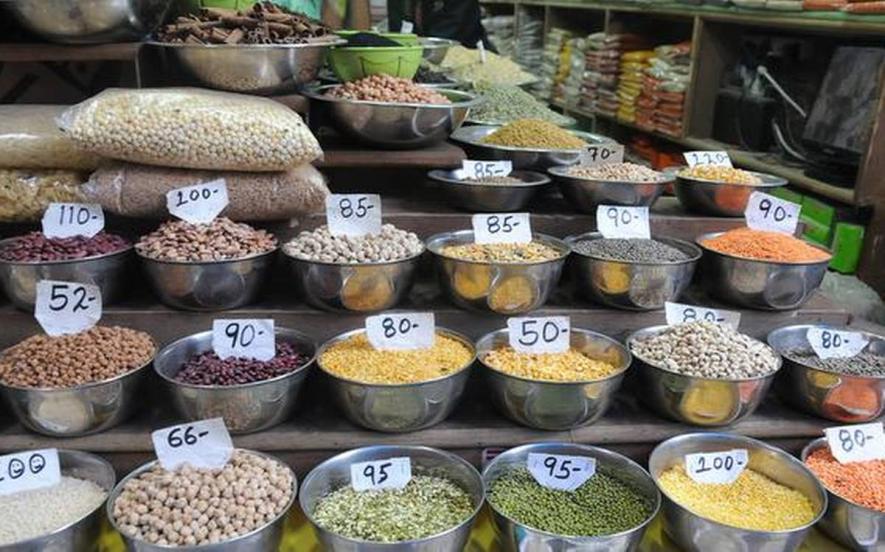Farmers’ Protest: Pitfalls of The Amended Essential Commodities Act

After the sudden announcement of the lockdown by Prime Minister Narendra Modi on March 24, the supply system for essential items, including food and agricultural products, was disrupted.
The hoarders used the crisis to make super profits and consumers were forced to pay an inflated price. On March 27, 2020, the district administration of Gurugram had seized 25,000 kgs of rice and 23,000 kgs of sugar from a store in Sector 29. It happened since the wholesale store was selling rice and sugar at very high prices.
One can possibly come across a range of news reports where The Essential Commodities Act, 1955, (ECA) was used in order to prevent hoarding; and in all such cases, the hoarders were selling essential commodities at rates higher than the market price or maximum retail price. After the amendment in 2020, the Act is being used for agricultural produce. If this amendment had been in place in the month of March, the district authority would have no role in preventing hoarding and the resultant inflation. The task of the Government to control inflation of necessary food products would be much more difficult then.
Why should the hoarding of food items remain illegal?
Hoarding is a most common tendency among profit-seekers, who want maximum control over supply. By doing so, they set the price, keeping the maximum profit share in mind. India is a country with high economic inequality, and the same is rising day-by-day. In such a scenario, ‘profit-led inflation’ can easily widen the gap between the rich and the poor. On one hand, with the severe economic slowdown and changes in the labour laws, the income of the majority of citizens are falling. On the other hand, with legalising hoarding, the consumption inequality is bound to increase.
What is the scope for Government control in case of inflation as per amended ECA?
In the amended ECA, Section 3, Subsection 1A, makes for the provision that regulation by the Government is only possible in the case of extraordinary circumstances like war, famine, extraordinary price rise and natural calamity of grave nature. Here, war and famine are relatively clear terms; natural calamity can also be notified by the Government; but, the price rise is defined specifically under point (b) of the same sub-section.
The amended ECA allows 100% retail inflation in case of horticultural produce and 50% for non-perishable agricultural products. There is no explanation from the Government on why the permissible inflation for the most necessary consumption items were kept very high. Food inflation, even at a much lower rate than the permissible level set by the amended ECA, can be a recipe for disaster. One must remember the protest demonstrations by the present ruling party when it was in Opposition – for all valid reasons – on an annual food inflation between 10 and 15 per cent.
The inflation data of various products suggests that even for a very high price rise, the amended Act would not have allowed the authorities to control hoarding of food items (table1). There are a few exceptions of very high price rise, which are ironically under the BJP regime.
Annual retail price rise (%) of different food products in the last decade.
Calculated using price data from Department of Consumer Affairs, Government of India.
The amended ECA, further states, “provided that such order for regulating stock limit shall not apply to a processor or value chain participant of any agricultural produce if the stock limit of such person does not exceed the overall ceiling of installed capacity of processing, or the demand for export in case of an exporter”.
There are three critical terms here which further reduces the Government’s scope; 1. value chain participants; 2. installed capacity; 3. demand for export. Every processing unit declares the ‘installed capacity’ as per various rules, but the challenge is somewhere else; it is measured in terms of quantity per hour/per day/per month.
Since it is measured in terms of time, a processing unit which is hoarding food items, can simply say that the stock is as per one year of installed capacity or so. Similarly, the demand for export can be projected at a maximum, but how can the Government estimate export demand for one particular exporter who is hoarding food products? Since the value chain participants include everyone from farming to consumption, so, excluding them from the condition of very high inflation, means every potential hoarder is allowed to hoard as per the amended ECA.
Who will benefit from this amendment?
The amended ECA defines “"value chain participant" in relation to any agricultural product, means and includes a set of participants, from production of any agricultural produce in the field to final consumption”.
The amended ECA makes the provision of ‘no-stock limit’ for ‘value chain participants’. Hence, it is pertinent to identify the potential beneficiary of this amendment. In terms of the participating population, the farming segment is the largest part of the value chain. In India, almost 86% of agricultural households are small and marginal landholders. There are enough studies which prove that under the various social-economic compulsions, the small and marginal farmers are always in a hurry to sell their harvest.
It is why the largest part of the farming population is not going to benefit from the above-mentioned relaxation. Functional storage facilities require several arrangements and hence, the ability to pile up stocks is directly proportional to capital ownership. The remaining segments of the value chain can be potential hoarders, but their capacity is dependent on the size of their economic status; needless to say, the majority of the Indian population are part of the lower economic strata.
As per the draft of the national land reform policy, there are 31% landless households in the country, 90% of the total households have land between zero to two hectare, and only five per cent households have more than three hectares of land.
Clearly, the amended ECA has nothing in it that will benefit the farmers, and its adverse impact will also be felt by the majority of Indian households.
The author is a research fellow at the Centre for Economic Studies and Planning in Jawaharlal Nehru University, New Delhi. The views are personal.
Get the latest reports & analysis with people's perspective on Protests, movements & deep analytical videos, discussions of the current affairs in your Telegram app. Subscribe to NewsClick's Telegram channel & get Real-Time updates on stories, as they get published on our website.
























